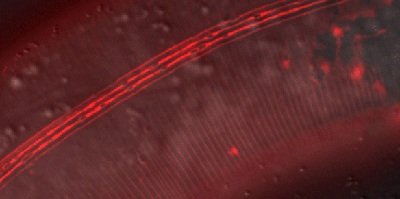Mycotoxin protects against nematodes

Researchers at ETH Zurich have isolated a protein from a fungus of the spruce which combats nematodes. The scientists hope that toxins of this kind will become the basis for the vaccination of livestock or domestic animals against zooparasitic nematodes.
Most terrestrial plants enter into biocoenosis with funghi. Both sides benefit: the fungus, which surrounds the small roots of the host plant with a thick felt, supplies the plant with trace elements and water. The plant, in turn, supplies the fungus with sugars and other metabolites which it is unable to produce itself.
Toxic protein kills intestinal cells
ETH researchers from the research group of microbiology professor Markus Aebi have discovered a protein in the cells of one such ectomycorrhizal fungus which offers an additional advantage to the fungus-plant duo. It protects the fungus and possibly its roots, too, against nematodes as it is toxic to the parasites. "This toxin is probably part of this fungus' defence system against predators", says Markus Künzler, senior assistant in Aebi's group. If the nematodes feed on the fungal cells, they ingest the toxic protein. The nematode's intestinal cells are destroyed by a mechanism which has still to be elucidated.
The mushroom mainly forms the protein in its pileus, i.e. the part of the fruiting body visible above ground and in the dense fungal net around the tips of the roots. The fact that the toxin is close to the root tips could be an indication that the toxin not only protects the fungus but also the plant roots against predators. Many nematodes that live in the soil feed not only on fungal tissue but also on plant cells.
Modified sugar as the docking station
In their study, which has just been published in the journal PNAS, the researchers demonstrate that the defence protein docks on to a specific target in the nematode : a modified sugar found on the surfaces of the worm's intestinal cells but also on those of molluscs like snails. However, there doesn't seem to be any such surface structure on the cells of vertebrates.
Furthermore, Künzler and his colleagues show that this point of attack is also found in specific bacteria which means that the toxic protein can also dock on there. As the protein has several binding points for the target structure, the protein and several bacteria form clumps, they "agglutinate".
"This reaction is interesting as close relatives of this protein, known as homologs have also been found in animals – ranging from invertebrates like the horseshoe crab to humans - where they play a role in the defence against bacteria", continues Künzler.
The fact that fungal and animal toxic proteins bind to the same target structures means that this defence mechanism must be very old in terms of evolution. This type of defence is part of the "innate" defence system of highly diverse organism groups like mushrooms, crabs or even humans.
Vaccinate livestock against parasites
This finding also paves the way for practical applications: the ETH spin-off Malcisbo, which came from the microbiologist's laboratory, endeavours, on the basis of these surface sugar structures to develop novel vaccines against parasites and pathogenic germs for livestock and humans. "The funghi reveal to us the Achilles heel of nematodes and bacteria. We can now use these findings to combat them", hopes Künzler.
More information: Wohlschlager T, et al. Methylated glycans as conserved targets of animal and fungal innate defense. PNAS Early Edition, published online 26 May 2014. DOI: 10.1073/pnas.1401176111
Journal information: Proceedings of the National Academy of Sciences
Provided by ETH Zurich




















